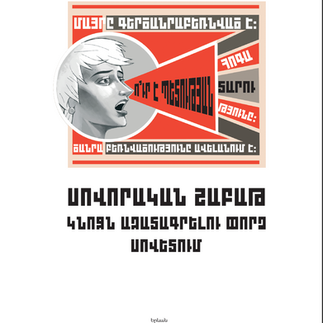Paradigma hosted around 120 participants at the presentation-discussion of its book on demography and the economic emancipation of women in the USSR.։
We presented and presented our new book to the participants, "Ordinary Week: An Attempt to Emancipate Women in the Soviet Union."


How do we "share" household chores today in Armenia?
Women spend more daily time on elderly care (an average of 0.5 hours), child care (an average of 3 hours, while men spend about 1 hour), housework (an average of 3.5 hours, while men spend about 1 hour), and self-education (an average of 1 hour, with a difference of 0.5 hours compared to men). Meanwhile, men spend more daily time on paid work (an average of 5 hours, while women spend about 2.5 hours) and leisure (an average of 5 hours).

Compared to Soviet statistics from 1987, the data has not changed much: women in the Soviet Union spent an average of three times more time on household chores. On working days, women spent an average of 3 hours compared to men's 58 minutes, and on weekends, women spent an average of 6 hours compared to men's 2 hours.

Is a woman a labor resource?
In Armenia, 20% of women enter the labor market after the age of 30. Between the ages of 24-29, there is a sharp increase in the gap between employed women and men due to childcare responsibilities.
The average age for women to have their first child is 25.9, and the average age for first marriage is 28.5 in cities and 26.8 in villages. The assertion that society invests in women's education but hardly uses the result sparked a lively debate about viewing women as a resource ("society invests money"), women's double/triple unpaid work, and several other important issues.


"Leave the kitchen..."
To liberate women from cooking and involve them in building socialism, the Soviet system tried to regulate what to eat, how, when, where, and how much.
Menus were set according to the nature of the work (e.g., 3800-4000 calories for weavers, 4500-5000 for diggers). Canned food, public canteens, and cooperative bakeries were seen as means of women's emancipation. Food was viewed as fuel for the working resource. The Soviet system was less about involving men in household chores and more about liberating women from tasks considered their "role."

And mothers are waiting...
The Soviet system also tried to emancipate women from preschool education, continuing the assertion that child-rearing is a crucial part of a woman's role.
Nevertheless, as of 1986, only 57% of children in the USSR were provided with permanent preschool education after about seventy years of work. However, while 70% of children in Russia or other Slavic countries had permanent preschool education, only 39% did in Armenia. This indicator is an example of the colonial nature of the empire. In Soviet Eastern regions, of which Armenia was a part, the provision of kindergartens did not exceed 50%, compared to about 60-70% in the more developed parts of the empire.


State feminism in the Soviet Nagorno-Karabakh Autonomous Region...
The Soviet system aimed to change the image of Eastern women, assuming it would transform the East. Rural women in Karabakh gained access to various social elevators (specialization, political quotas, as is now in Armenia...).
However, one should not overestimate the level of gender equality in the USSR: the monopolistic patriarchal state replaced the communal patriarchal father.

Constructing the new Soviet woman...
Stories in women's magazines were one of the important tools for creating the new Soviet woman. Studying them allows us to distinguish four recurring characters: "hero woman," "emancipated woman," "unhappy woman," and "backward woman."
The "hero woman" was an emancipated party woman who came from the city to educate the village, in line with the empire's enlightenment aspirations. The "emancipated woman" was the former backward woman who had become accessible to the Soviet model. The "unhappy woman" was the backward woman who did not join the emancipation of women.


Demography plays a key role...
The prohibition of abortion and the promotion of reproduction aimed to pull Soviet demography out of decline.
In contrast to the Soviet totalitarian model, the new demographic strategy of the Republic of Armenia is liberal. The goal is to create an environment where the decision to have a child will depend entirely on the parents' will and will not limit (editor's note: the woman's) opportunities for education, work, and human capital development, as there will be comprehensive state support at all stages of family creation, and not coercion.
Why target women?

Why do emancipation policies particularly target women? The Soviet system, by prohibiting abortion and promoting reproduction, extended its totalitarian policy to women's bodies as well.
In that sense, not much has changed. States continue to target women's bodies and reproductive rights. It is perhaps worth mentioning two examples from the club of democratic countries. In the United States, the Roe v. Wade court ruling was overturned, and France enshrined the right to abortion in its constitution.
Ordinary Week: A Soviet Attempt to Emancipate Women.
"Ordinary Week" is an educational graphic novel. It presents the Soviet attempt to economically liberate women with a critical approach: from its revolutionary goals to its impasse. The book focuses on the story of one week of a young Soviet urban woman. The book includes 15 tables of statistical data, more than 20 magazine articles, a historical overview, and an active thinking questionnaire. The book is intended for critical teaching of the Soviet past.
The book was published with the support of the Friedrich Naumann Foundation For Freedom-Armenia in a print run of 250 copies, of which 120 copies were donated to the participants of the event, and the remaining 130 copies will be distributed to several schools.

















Commentaires